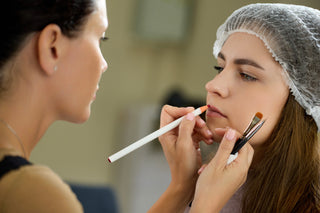

The healing process in permanent makeup is a crucial part of achieving the best results, but it’s often misunderstood or overlooked by both artists and clients. Knowing what to expect at each stage of healing can prevent unnecessary panic, ensure better aftercare, and ultimately lead to more beautiful, long-lasting results. In this guide, we’ll break down the entire healing process step-by-step and discuss how both artists and clients can contribute to successful recovery.
Stage 1: Initial Swelling and Redness (Days 1-2)
Right after the procedure, swelling and redness are completely normal. Depending on the area treated (lips, brows, eyeliner), the level of swelling can vary. For lip treatments, swelling might be more pronounced and last longer than for brows or eyeliner. The skin is reacting to the trauma caused by the needle and will begin to protect the area with natural inflammatory responses.
Clients may feel nervous at this stage, especially if they aren’t prepared for how swollen or dark the pigment can initially appear.
Pro Tip for Artists: Always advise your clients that swelling and dark pigmentation are temporary. Reassure them that the final color will settle into a more natural tone within the coming days.

Stage 2: Darkening of the Pigment (Days 3-5)
As the skin begins to heal, the pigment will start to darken. This is because the top layer of the skin is regenerating, and the pigment is mixed with lymphatic fluid, which causes it to appear much darker than intended. Clients might panic at this stage, thinking the pigment will remain too dark, especially with brows, where the difference can be dramatic.
Using high-quality pigments like Brovi pigments can help ensure more predictable healing and color stability.
What to Tell Your Clients: Explain to your clients that this stage is temporary. The pigment is not permanent at this color level, and the scabs that form will naturally exfoliate, revealing the true color beneath.

Stage 3: Scabbing and Peeling (Days 5-10)
The skin will begin to scab, and the pigment will appear patchy. This is the most uncomfortable stage for clients, as they might feel like the procedure didn’t take well or that the results are uneven. The peeling process can also be itchy, and some clients may be tempted to scratch or pick at the scabs, which can lead to pigment loss and scarring.
Pro Tip for Clients: Emphasize the importance of leaving the scabs alone. Picking at scabs during the healing process can result in the pigment being pulled out, leading to uneven color or permanent scarring.

Stage 4: Lightening of the Pigment (Days 10-30)
After the scabs have fallen off, the pigment will often appear much lighter than expected. At this stage, clients may feel disappointed, thinking the pigment didn’t hold. However, this is just the pigment settling beneath the newly healed skin. Over the next few weeks, the color will gradually return as the skin fully regenerates and the pigment stabilizes.
For artists using Swiss Color pigments, it's important to inform clients that these pigments are designed for excellent retention and will reveal their true color during this stage.
For Artists: Educate your clients on how this lightening phase is normal and that the pigment will darken again within a few weeks. This is the time to set up a touch-up appointment for optimal results.

Stage 5: Full Color Settling (Weeks 4-6)
By the fourth to sixth week, the permanent makeup should settle into its final color. The skin has had time to fully regenerate, and the pigment that remains will be close to the intended shade. This is also the time to evaluate whether a touch-up is needed, as some areas might have healed lighter or more patchy than others.
Why Touch-Ups Are Important: Permanent makeup is a two-step process for most clients. The initial procedure lays the foundation, but the touch-up appointment ensures even color distribution and lasting results. Clients who skip the touch-up might experience premature fading or uneven color retention.
Recommended Product:
For touch-ups, use Etalon Mix Hybrid Brow Pigments, which offer great color stability and fade resistance for long-lasting results. Shop Etalon Mix Hybrid Brow Pigments.

Common Healing Concerns and How to Address Them
Many clients, especially first-timers, may not be familiar with the healing process and could misinterpret some normal stages as signs of something going wrong. Here are some common concerns clients might express, and how you can address them:
- "My brows are too dark!"
– Reassure your client that this is a normal part of the process and the color will lighten as the skin heals. - "My lips feel dry and cracked."
– Advise them to apply a hydrating balm like Hanafy Lip Care Balm to keep their lips moisturized. Shop Hanafy Lip Care Balm. - "It looks patchy after peeling."
– Let them know this is temporary and a touch-up will help even out any inconsistencies.
Educating Your Clients for Better Healing
One of the most effective ways to ensure that your clients have a smooth healing process is through education. Providing them with clear, step-by-step aftercare instructions will minimize confusion and reduce the risk of post-treatment complications.
Consider offering clients an Aftercare Card with detailed instructions they can refer to during the healing process. Better yet, provide a care package with everything they’ll need for recovery, such as a healing ointment, SPF balm, and instructions on how to care for their new permanent makeup.
Example: You could create a bundled PMU Aftercare Kit, including all the necessary products like Aquaphor, SPF Lip Balm, and soothing Hyaluronic Serum. Shop PMU Aftercare Kit.
Final Thoughts: Why Understanding Healing Stages Matters
Understanding the healing stages of permanent makeup is just as important as mastering the application techniques. By being able to anticipate and explain the process to your clients, you can manage their expectations, reduce their anxiety, and improve the overall satisfaction with their results. Moreover, it ensures that they’re equipped with the knowledge and tools to take care of their new brows, lips, or eyeliner.
With the right products, knowledge, and support, both artists and clients can navigate the healing journey confidently, resulting in beautiful, lasting permanent makeup.
